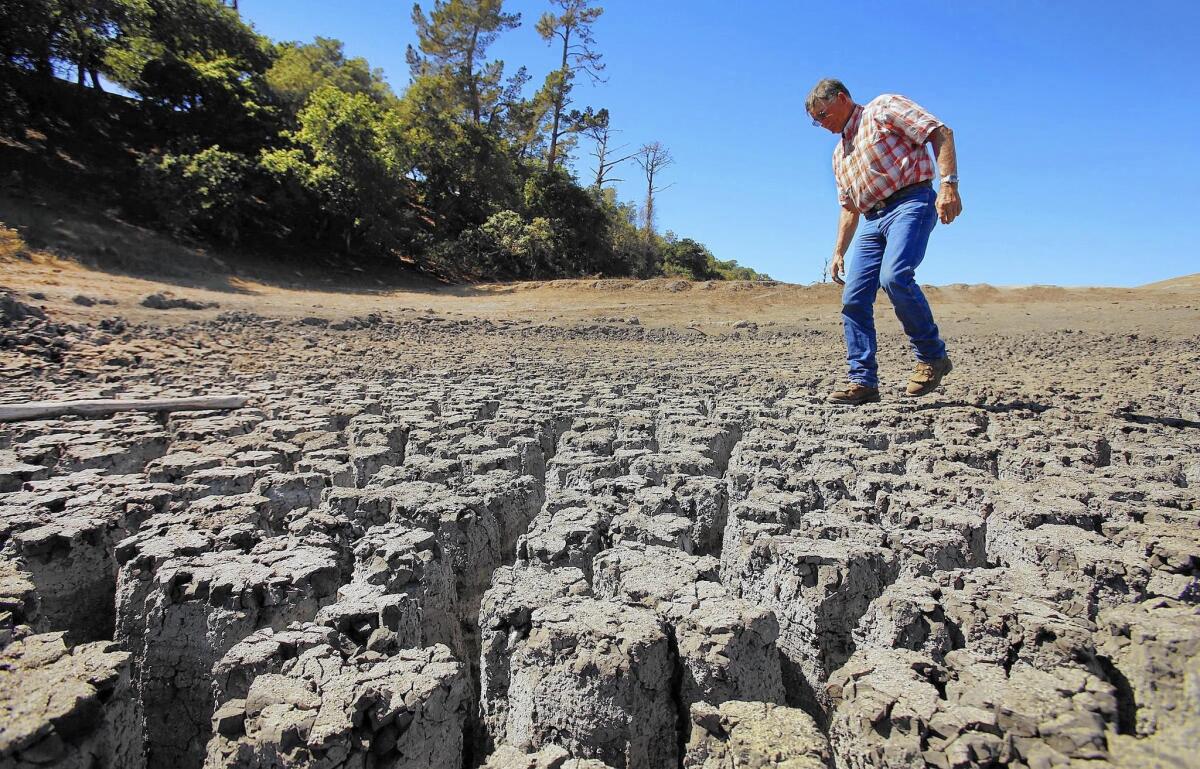Gov. Brown, lawmakers plan short- and long-term strategy on drought

- Share via
Reporting from SACRAMENTO — Politicians don’t have the power to make it rain, so on Thursday they tried the next best thing — they proposed showering California’s parched landscape with money.
Gov. Jerry Brown and top lawmakers from both parties unveiled a plan that would invest more than $1 billion to improve the state’s water infrastructure, provide emergency assistance to struggling communities and protect wildlife.
“This is a struggle,” Brown said during a Capitol news conference. “Something we’re going to have to live with. For how long, we’re not sure.”
With snow levels in the Sierra Nevada dramatically below normal and California in its fourth consecutive year of drought, lawmakers touting the emergency relief plan acknowledged their limitations.
Assembly minority leader Kristin Olsen (R-Modesto) called the proposal a “Band-Aid,” and Assembly Speaker Toni Atkins (D-San Diego) cautioned that it “will not solve our water emergency.” Lawmakers are expected to act next week on the legislation, which Senate leader Kevin de León (D-Los Angeles) said is “just a down payment on our efforts.”
Most of the plan involves spending bond funds that voters already approved or paying money faster than previously scheduled. Some projects may not be completed for years.
Only a small fraction of the proposal announced Thursday — $27.4 million — requires new funding. That money would largely be used to deliver food and water to Californians in the Central Valley.
The proposal also would tap into a $7.5-billion water bond that voters approved in November, spending $272.7 million to safeguard drinking water and support recycling and desalination initiatives.
The biggest chunk of funding in the measure would not directly address the drought. Flood control projects would get about $660 million, included in a bond measure passed by voters a decade ago and scheduled to expire next year.
Brown explained the inclusion of that money by warning of “extreme weather events” that can be caused by climate change.
“All of a sudden, when you’re all focused on drought, you can get massive storms that flood through these channels and overflow and cause havoc,” he said.
Interest groups saw an upside in the emphasis on flood protection in a plan for drought relief. Jay Ziegler, California policy director for the Nature Conservancy, said improving the state’s levees could help capture rain when it returns and replenish groundwater that farmers in the Central Valley have aggressively depleted.
“History shows us that every time California comes out of one of these droughts, it’s with a boom-and-bust cycle of rain,” he said.
Unions praised the potential economic benefits of building new flood controls. Robbie Hunter, president of the California State Building & Construction Trades Council, said “this much-needed investment to upgrade our water infrastructure will provide tens of thousands of construction jobs in the areas most in need and impacted by the drought.”
This is the second consecutive year that lawmakers have considered emergency legislation to address the drought.
Last year, Brown signed a $687.4-million bill for infrastructure projects using previously approved bond money. The measure also funded aid to communities facing acute water shortages.
So far, a third of that money has been spent, said Richard Stapler, spokesman for the California Natural Resources Agency.
The latest proposal comes amid growing concern about the state’s dry conditions.
On Tuesday, the State Water Board tightened its watering restrictions, telling urban agencies to limit the number of days residents can water their yards.
The board also warned that it would impose tougher restrictions in coming months if local agencies don’t ramp up conservation efforts.
“We are not seeing the level of stepping up and ringing the alarm bells that the situation warrants,” said Felicia Marcus, chairwoman of the State Water Resources Control Board.
So far, the board has stopped short of mandatory limits on water use. On Thursday, Brown didn’t rule out taking such a drastic step in the future.
“It’s a judgment call,” he said. “But I’ve been asking that same question myself.”
Senate minority leader Bob Huff (R-Diamond Bar) emphasized the need for Californians to use less.
“Everyone in the state has to ask the question — how can I conserve more water?” he said.
The state’s water situation is in some respects slightly better than it was a year ago. Precipitation in key watersheds in Northern California is 81% of normal for the date. Shasta Lake, California’s largest reservoir, is 58% full, compared with 45% a year ago. Lake Oroville is half full, compared with 45% at this time last year.
Customers of the State Water Project, which delivers supplies from Northern California to Southland cities, will get 20% of their contract requests, compared with only 5% in 2014.
But water managers are troubled by the minimal snow in the mountains, which is at 12% of average levels, down from 28% last year.
The mountain snowpack acts as a natural reservoir that, in a normal year, can hold as much as a third of the state’s water supply, slowly releasing it throughout the spring as seasonal water demand rises. This year that release will be a trickle.
Twitter: @chrismegerian
Twitter: @melmason
More to Read
Sign up for Essential California
The most important California stories and recommendations in your inbox every morning.
You may occasionally receive promotional content from the Los Angeles Times.












